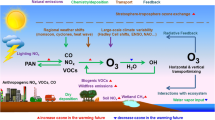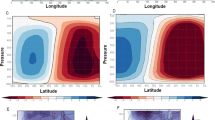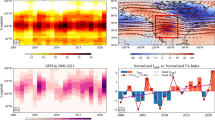Abstract
Moisture contribution and transport pathways for Central Asia (CA) are quantitatively examined using the Lagrangian water cycle model based on reanalysis and observational data to explain the precipitation seasonality and the moisture transport variation during 1979–2015. Westerly-related (northwesterly and westerly) transport explains 42% of CA precipitation and dominates in southwest CA, where precipitation is greatest in the cold season. Southeast CA, including part of Northwest China, experiences its maximum precipitation in the warm season and is solely dominated by southerly transport, which explains about 48% of CA precipitation. The remaining 10% of CA precipitation is explained by northerly transport, which steadily impacts north CA and causes a maximum in precipitation in the warm season. Most CA areas are exposed to seasonally varying moisture transport, except for southeast and north CA, which are impacted by southerly and northerly transport year-round. In general, the midlatitude westerlies-driven transport and the Indian monsoon-driven southerly-related transport explain most of the spatial differences in precipitation seasonality over CA. Moreover, the contribution ratio of local evaporation in CA to precipitation exhibits significant interdecadal variability and a meridionally oriented tripole of moisture transport anomalies. Since the early 2000s, CA has experienced a decade of anomalously low local moisture contribution, which seems jointly determined by the weakened moisture contribution from midlatitudes (the Atlantic, Europe, and CA itself) and the enhanced contribution from high latitudes (West Siberia and the Arctic) and tropical areas (South Asia and the Indian Ocean).
摘 要
本文基于再分资料和观测资料,利用拉格朗日框架下的水循环模型定量化分析了1979–2015中亚地区降水的水汽贡献和输送路径及其季节性变化。研究表明,中亚西南部地区的降水在冷季达到其最大值,该区域的水汽来源主要受西风(包括西北风和西风)水汽输送控制 ,且整体而言西风水汽输送贡献了42%的中亚降水。中亚东南部地区(含中国西北)则相反,最大降水通常出现在暖季,且常年相对稳定地受控于南风水汽输送。南风水汽输送则解释了中亚整体降水的48%。除以上两支主要的输送带外,北风水汽输送供给了剩余约10%的中亚降水,且其常年稳定地影响中亚北部地区,并导致该区域的最大降水季出现在暖季。整体而言,除了东南部地区和北部地区分别全年稳定地受控于南风水汽输送和北风水汽输送外,中亚其他区域的水汽来源路径存在明显的季节变化。这种降水季节变化的空间差异主要是由中纬度西风驱动的水汽输送与印度季风驱动的南风水汽输送共同作用所决定的。作为另一重要的水汽来源,中亚区域的局地蒸发引起的降水占比例存在显著的年代际变率,并同时对应了经向三极型水汽输送异常型。自2000s早期开始,来自中亚内部局地蒸发的水汽贡献处于长达十余年的异常低值期。这一时期出现了持续减弱的来自中纬度地区(包括大西洋、欧洲和中亚自身)的水汽贡献,同时伴随着增强的来自高纬度地区(包括西西伯利亚和北极)和热带地区(包括南亚和印度洋)的水汽贡献。
Similar content being viewed by others
References
Badescu, V., and R. B. Cathcart, 2011: Aral Sea partial restoration. II. Simulation of time-dependent processes. International Journal of Environment and Waste Management, 7, 164–174.
Baldwin, J., and G. Vecchi, 2016: Influence of the Tian Shan on arid extratropical Asia. J. Climate, 29, 5741–5762, https://doi.org/10.1175/JCLI-D-15-0490.1.
Berrisford, P, Dee, DP, Poli, P, Brugge, R, Fielding, M, Fuentes, M, Kållberg, PW, Kobayashi, S, Uppala, S, Simmons, A., 2011: The ERA-Interim Archive. 2nd ed., ERA Report Series No. 1.
Böhner, J., 2006: General climatic controls and topoclimatic variations in Central and High Asia. Boreas, 35, 279–295, https://doi.org/10.1111/j.1502-3885.2006.tb01158.x.
Bothe, O., K. Fraedrich, and X. H. Zhu, 2012: Precipitation climate of Central Asia and the large-scale atmospheric circulation. Theor. Appl. Climatol., 108, 345–354, https://doi.org/10.1007/s00704-011-0537-2.
Brubaker, K. L., D. Entekhabi, and P. S. Eagleson, 1993: Estimation of continental precipitation recycling. J. Climate, 6, 1077–1089, 10.1/75/1504-0449(3900)006<1077:EOCPR>2.0.CO;2.
Cavazos, T., A. C. Comrie, and D. M. Liverman, 2002: Intraseasonal variability associated with wet monsoons in Southeast Arizona. J. Climate, 15, 2477–2490, https://doi.org/10.1175/1520-0442(2002)015<2477:IVAWWM>2.0.CO;2.
Chen, F.-H., and Coauthors, 2010: Moisture changes over the last millennium in arid central Asia: A review, synthesis and comparison with monsoon region. Quaternary Science Reviews, 29, 1055–1068, https://doi.org/10.1016/j.quascirev.2010.01.005.
Ciric, D., M. Stojanovic, A. Drumond, R. Nieto, and L. Gimeno, 2016: Tracking the origin of moisture over the Danube river basin using a Lagrangian approach. Atmospheee, 7, 162, https://doi.org/10.3390/atmos7120162.
Cohen, J., and Coauthors, 2014: Recent Arctic amplification and extreme mid-latitude weather. Nature Geoscience, 7, 627–637, https://doi.org/10.1038/ngeo2234.
de Beurs, K. M., G. M. Henebry, B. C. Owsley, and I. N. Sokolik, 2018: Large scale climate oscillation impacts on temperature, precipitation and land surface phenology in Central Asia. Environmental Research Letters, 13, 065018, https://doi.org/10.1088/1748-9326/aac4d0.
de Vries, A. J., S. B. Feldstein, M. Riemer, E. Tyrlis, M. Sprenger, M. Baumgart, M. Fnais, and J. Lelieveld, 2016: Dynamics of tropical-extratropical interactions and extreme precipitation events in Saudi Arabia in autumn, winter and spring. Quart. J. Roy. Meteor. Soc., 142, 1862–1880, https://doi.org/10.1002/qj.2781.
Dee, D. P., and Coauthors, 2011: The ERA-Interim reanalysis: Configuration and performance of the data assimilation system. Quart. J. Roy. Meteor. Soc., 137, 553–597, https://doi.org/10.1002/qj.828.
Dominguez, F., P. Kumar, X.-Z. Liang, and M. F. Ting, 2006: Impact of atmospheric moisture storage on precipitation recycling. J. Climate, 19, 1513–1530, https://doi.org/10.1175/JCLI3691.1.
Domrös, M., and G. B. Peng, 1988: The Climate of China. Springer, 360 pp.
Drumond, A., R. Nieto, and L. Gimeno, 2011: Sources of moisture for China and their variations during drier and wetter conditions in 2000–2004: A Lagrangian approach. Climate Research, 50, 215–225, https://doi.org/10.3354/cr01043.
Eltahir, E. A. B., and R. L. Bras, 1994: Precipitation Recycling in the Amazon Basin. Quart. J. Roy. Meteor. Soc., 100, 861–880, https://doi.org/10.1002/qj.49712051806.
Gimeno, L., and Coauthors, 2012: Oceanic and terrestrial sources of continental precipitation. Rev. Geophys., 50, RG4003, https://doi.org/10.1029/2012RG000389.
Giorgi, F., 2006: Climate change hot-spots. Geophys. Res. Lett., 33, L08707, https://doi.org/10.1029/2006GL025734.
Hu, H. C., and F. Dominguez, 2015: Evaluation of oceanic and terrestrial sources of moisture for the North American monsoon using numerical models and precipitation stable isotopes. Journal of Hydrometeorology, 16, 19–35, https://doi.org/10.1175/JHM-D-14-0073.1.
Hu, Z. Y., Q. Hu, C. Zhang, X. Chen, and Q. X. Li, 2016: Evaluation of reanalysis, spatially interpolated and satellite remotely sensed precipitation data sets in central Asia. J. Geophys. Res., 121, 5648–5663, https://doi.org/10.1002/2016JD024781.
Hua, L. J., L. H. Zhong, and Z. G. Ma, 2017: Decadal transition of moisture sources and transport in northwestern China during summer from 1982 to 2010. J. Geophys. Res., 122, 12 522–12 540, https://doi.org/10.1002/2017JD027728.
Huang, X., Zhou, T., Turner, A., Dai, A., Chen, X., Clark, R., Jiang, J., Man, W., Murphy, J., Rostron, J., Wu, B., Zhang, L., Zhang, W., & Zou, L., 2020: The recent decline and recovery of Indian summer monsoon rainfall: relative roles of external forcing and internal variability. J. Climate, 33(12), 5035–5060, https://doi.org/10.1175/JCLI-D-19-0833.1.
Jiang, J., T. J. Zhou, H. L. Wang, Y. Qian, D. Noone, and W. M. Man, 2020: Tracking moisture sources of precipitation over central Asia: A study based on the water-source-tagging method. J. Climate, 33, 10 339–10 355, https://doi.org/10.1175/JCLI-D-20-0169.1.
Joseph, P. V., and S. Sijikumar, 2004: Intraseasonal variability of the low-level jet stream of the Asian summer monsoon. J. Climate, 17, 1449–1458, https://doi.org/10.1175/1520-0442(2004)017<1449:IVOTLJ>2.0.CO;2.
Keys, P. W., R. J. van der Ent, L. J. Gordon, H. Hoff, R. Nikoli, and H. H. G. Savenije, 2012: Analyzing precipitationsheds to understand the vulnerability of rainfall dependent regions. Biogeosciences, 9, 733–746, https://doi.org/10.5194/bg-9-733-2012.
Klein, I., U. Gessner, and C. Kuenzer, 2012: Regional land cover mapping and change detection in Central Asia using MODIS time-series. Applied Geography, 35, 219–234, https://doi.org/10.1016/j.apgeog.2012.06.016.
Kohonen, T., 1982: Self-organized formation of topologically correct feature maps. Biological Cybernetics, 43, 59–69, https://doi.org/10.1007/BF00337288.
Kohonen, T., 1998: The self-organizing map. Neurocomputing, 11, 1–6, https://doi.org/10.1016/S0925-2312(98)00030-7.
Lioubimtseva, E., and G. M. Henebry, 2009: Climate and environmental change in arid central Asia: Impacts, vulnerability, and adaptations. Journal of Arid Environments, 13, 963–977, https://doi.org/10.1016/j.jaridenv.2009.04.022.
Liu, Y. G., R. H. Weisberg, and C. N. K. Mooers, 2006: Performance evaluation of the self-organizing map for feature extraction. J. Geophys. Res., 111, C05018, https://doi.org/10.1029/2005JC003117.
Risien, C. M., C. J. C. Reason, F. A. Shillington, and D. B. Chelton, 2004: Variability in satellite winds over the Benguela upwelling system during 1999–2000. J. Geophys. Res., 109, C03010, https://doi.org/10.1029/2003JC001880.
Schiemann, R., D. Lüthi, P. L. Vidale, and C. Schär, 2008: The precipitation climate of Central Asia-intercomparison of observational and numerical data sources in a remote semiarid region. International Journal of Climatology, 28, 295–314, https://doi.org/10.1002/joc.1532.
Schneider, U., Becker, A., Finger, P., Meyer-Christoffer, A., Rudolf, B. and Ziese, M., 2015: GPCC Full Data Reanalysis Version 7.0 at 0.5: Monthly Land-Surface Precipitation from Rain-Gauges Built on GTS-Based and Historic Data. Global Precipitation Climatology Centre, 1–13.
Serreze, M. C., A. P. Barrett, J. C. Stroeve, D. N. Kindig, and M. M. Holland, 2009: The emergence of surface-based Arctic amplification. The Cryosphere, 3, 11–19, https://doi.org/10.5194/tc-3-11-2009.
Shi, Y. F., Y. P. Shen, E. S. Kang, D. L. Li, Y. J. Ding, G. W. Zhang, and R. J. Hu, 2007: Recent and future climate change in northwest China. Climatic Change, 80, 379–393, https://doi.org/10.1007/s10584-006-9121-7.
Siegfried, T., T. Bernauer, R. Guiennet, S. Sellars, A. W. Robertson, J. Mankin, P. Bauer-Gottwein, and A. Yakovlev, 2012: Will climate change exacerbate water stress in Central Asia. Climatic Change, 112, 881–899, https://doi.org/10.1007/s10584-011-0253-z.
Sodemann, H., and A. Stohl, 2009: Asymmetries in the moisture origin of Antarctic precipitation. Geophys. Res. Lett., 36, L22803, https://doi.org/10.1029/2009GL040242.
Song, S. K., and J. Bai, 2016: Increasing winter precipitation over arid central Asia under global warming. Atmosphere, 1, 139, https://doi.org/10.3390/atmos7100139.
Trenberth, K. E., A. G. Dai, R. M. Rasmussen, and D. B. Parsons, 2003: The changing character of precipitation. Bull. Amer. Meteor. Soc., 84, 1205–1218, https://doi.org/10.1175/BAMS-84-9-1205.
Trenberth, K. E., J. T. Fasullo, and J. Mackaro, 2011: Atmospheric moisture transports from ocean to land and global energy flows in reanalyses. J. Climate, 14, 4907–4924, https://doi.org/10.1175/2011JCLI4171.1
van der Ent, R. J., H. H. G. Savenije, B. Schaefli, and S. C. Steele-Dunne, 2010: Origin and fate of atmospheric moisture over continents. Water Resour. Res., 46, W09525, https://doi.org/10.1029/2010WR009127.
Vries, P., and Doos, K., 2001: Calculating Lagrangian trajectories using time-dependent velocity fields. Journal of Atmospheric and Oceanic Technology, 18(6), 1092–1101, https://doi.org/10.1175/1520-0426(2001)018<1092:CLTUTD>2.0.CO;2.
Wang, K. C., and R. E. Dickinson, 2012: A review of global terrestrial evapotranspiration: Observation, modeling, climatology, and climatic variability. Rev. Geophys., 50, RG2005, https://doi.org/10.1029/2011rg000373.
Wang, S. J., M. J. Zhang, Y. J. Che, F. L. Chen, and F. Qiang, 2016: Contribution of recycled moisture to precipitation in oases of arid central Asia: A stable isotope approach. Water Resour. Res., 52, 3246–3257, https://doi.org/10.1002/2015WR018135.
Wei, J. F., P. A. Dirmeyer, M. G. Bosilovich, and R. G. Wu, 2012: Water vapor sources for Yangtze River valley rainfall: Climatology, variability, and implications for rainfall forecasting. J. Geophys. Res., 117, D05126, https://doi.org/10.1029/2011JD016902.
Wei, K., and L. Wang, 2013: Reexamination of the aridity conditions in arid northwestern China for the last decade. J. Climate, 26, 9594–9602, https://doi.org/10.1175/JCLI-D-12-00605.1.
Wei, N., Y.-F. Gong, X. Sun, and J.-G. Fang, 2010: Variation of precipitation and water vapor transport over the northwest China from 1959 to 2005. Journal of Desert Research, 30, 1450–1457. (in Chinese with English abstract)
Yang, X. P., L. Scuderi, P. Paillou, Z. T. Liu, H. W. Li, and X. Z. Ren, 2011: Quaternary environmental changes in the drylands of China-A critical review. Quaternary Science Reviews, 30, 3219–3233, https://doi.org/10.1016/j.quascirev.2011.08.009.
Yatagai, A., and T. Yasunari, 1998: Variation of summer water vapor transport related to precipitation over and around the arid region in the interior of the Eurasian continent. J. Meteor. Soc. Japan, 66, 799–815, https://doi.org/10.2151/jmsj1965.76.5_799.
Zhai, J. Q., B. D. Su, V. Krysanova, T. Vetter, C. Gao, and T. Jiang, 2010: Spatial variation and trends in PDSI and SPI indices and their relation to streamflow in 10 large regions of China. J. Climate, 23, 649–663, https://doi.org/10.1175/2009JCLI2968.1.
Zhang, Z. X., C.-Y. Xu, B. Yong, J. J. Hu, and Z. H. Sun, 2012: Understanding the changing characteristics of droughts in Sudan and the corresponding components of the hydrologic cycle. Journal of Hydrometeorology, 13, 1520–1535, https://doi.org/10.1175/JHM-D-11-0109.1.
Zhong, L. H., L. J. Hua, Z. G. Ma, and Y. Yao, 2019: A quantitative study of moisture transport variation on the interdecadal variation of the summer precipitation in South China from 1979 to 2015. Climate Dyn., 53, 4743–4761, https://doi.org/10.1007/s00382-019-04822-0.
Zhong, L. H., L. J. Hua, Y. Yao, and J. M. Feng, 2021: Inter-decadal aridity variations in Central Asia during 1950–2016 regulated by oceanic conditions under the background of global warming. Climate Dyn., 56, 3665–3686, https://doi.org/10.1007/s00382-021-05659-2.
Acknowledgements
This research was jointly supported by the Strategic Priority Research Program of Chinese Academy of Sciences under Grant No. XDA20020201 and the National Natural Science Foundation of China (NSFC) under Grant Nos. 41975099, U2006210, and 41475072.
Author information
Authors and Affiliations
Corresponding author
Additional information
Article Highlights
• The moisture contribution and transport pathway for Central Asia in relation to the seasonal variability of the precipitation is quantitatively examined.
• The areas affected by westerly transport and monsoon transport to Central Asia, as well as their seasonal variations of precipitation, are presented.
• The interdecadal variability of the moisture contribution from local evaporation in Central Asia combined with the external moisture transport is revealed.
Rights and permissions
About this article
Cite this article
Zhong, L., Hua, L., Gong, Z. et al. Quantifying the Spatial Characteristics of the Moisture Transport Affecting Precipitation Seasonality and Recycling Variability in Central Asia. Adv. Atmos. Sci. 39, 967–984 (2022). https://doi.org/10.1007/s00376-021-1383-5
Received:
Revised:
Accepted:
Published:
Issue Date:
DOI: https://doi.org/10.1007/s00376-021-1383-5
Key words
- Central Asia
- precipitation seasonality
- recycling ratio
- moisture transport
- dynamical recycling model
- interdecadal variability




